Page 285 of 442

285 Operation
Engine compartment
1Filler cap�
Unscrew filler cap1 from filler neck.
�
Add engine oil as required. Be careful
not to overfill with oil.
Be careful not to spill any oil when adding.
Avoid environmental damage caused by oil
entering the ground or water.
�
Screw filler cap1 back on filler neck.
More information on engine oil can be
found in the “Technical data” section
(
�page 400) and (
�page 403).
Transmission fluid level
The transmission fluid level does not need
to be checked. If you notice transmission
fluid loss or gear shifting malfunctions,
have an authorized Mercedes-Benz Center
check the transmission.Coolant level
The engine coolant is a mixture of water
and anticorrosion/antifreeze. To check
the coolant level, the vehicle must be
parked on level ground and the engine
must be cool.
The coolant expansion tank is located on
the driver’s side of the engine compart-
ment.
!Excess oil must be siphoned or drained
off. It could cause damage to the
engine and catalytic converter not
covered by the Mercedes-Benz Limited
Warranty.
Page 287 of 442
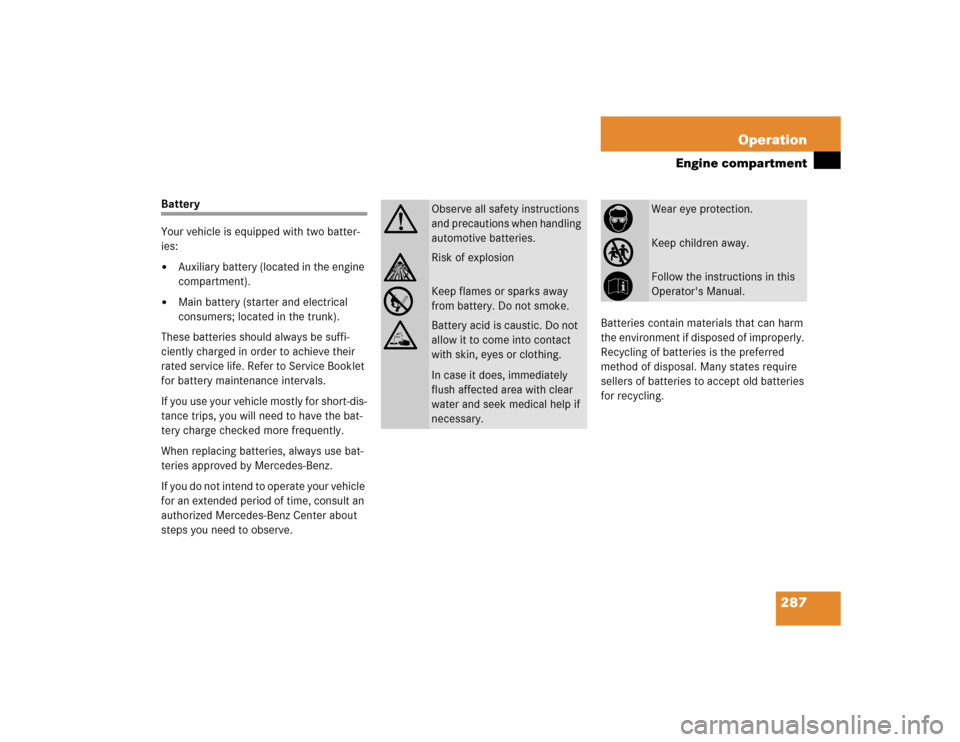
287 Operation
Engine compartment
Battery
Your vehicle is equipped with two batter-
ies:�
Auxiliary battery (located in the engine
compartment).
�
Main battery (starter and electrical
consumers; located in the trunk).
These batteries should always be suffi-
ciently charged in order to achieve their
rated service life. Refer to Service Booklet
for battery maintenance intervals.
If you use your vehicle mostly for short-dis-
tance trips, you will need to have the bat-
tery charge checked more frequently.
When replacing batteries, always use bat-
teries approved by Mercedes-Benz.
If you do not intend to operate your vehicle
for an extended period of time, consult an
authorized Mercedes-Benz Center about
steps you need to observe.Batteries contain materials that can harm
the environment if disposed of improperly.
Recycling of batteries is the preferred
method of disposal. Many states require
sellers of batteries to accept old batteries
for recycling.
G
Observe all safety instructions
and precautions when handling
automotive batteries.
A
Risk of explosion
D
Keep flames or sparks away
from battery. Do not smoke.
B
Battery acid is caustic. Do not
allow it to come into contact
with skin, eyes or clothing.
In case it does, immediately
flush affected area with clear
water and seek medical help if
necessary.
E
Wear eye protection.
C
Keep children away.
F
Follow the instructions in this
Operator's Manual.
Page 295 of 442
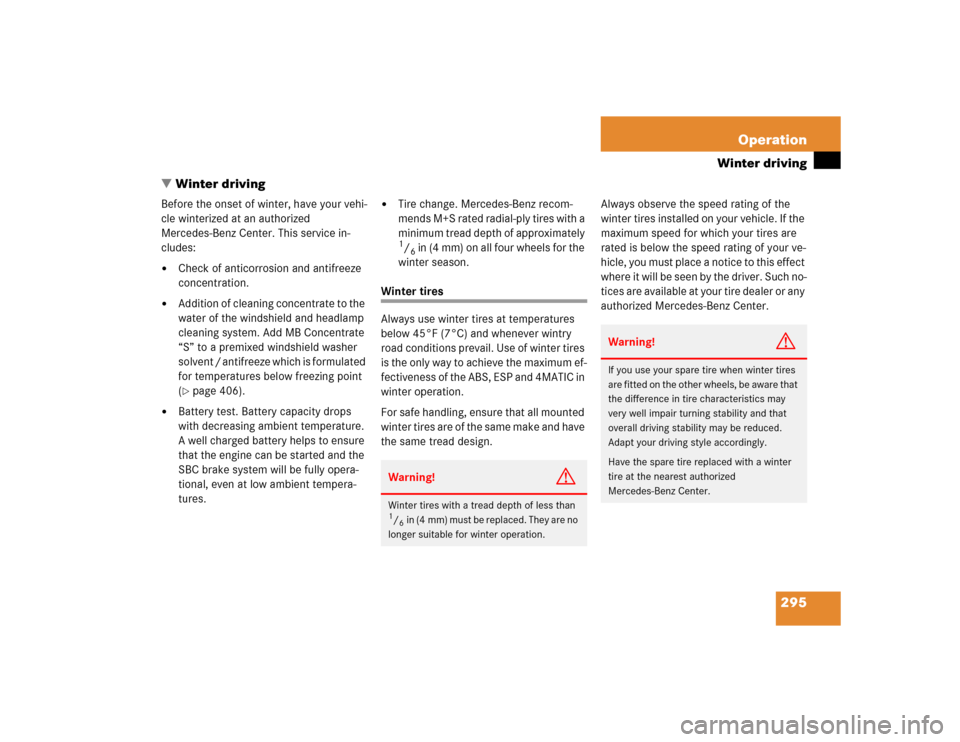
295 Operation
Winter driving
�Winter driving
Before the onset of winter, have your vehi-
cle winterized at an authorized
Mercedes-Benz Center. This service in-
cludes:�
Check of anticorrosion and antifreeze
concentration.
�
Addition of cleaning concentrate to the
water of the windshield and headlamp
cleaning system. Add MB Concentrate
“S” to a premixed windshield washer
solvent / antifreeze which is formulated
for temperatures below freezing point
(�page 406).
�
Battery test. Battery capacity drops
with decreasing ambient temperature.
A well charged battery helps to ensure
that the engine can be started and the
SBC brake system will be fully opera-
tional, even at low ambient tempera-
tures.
�
Tire change. Mercedes-Benz recom-
mends M+S rated radial-ply tires with a
minimum tread depth of approximately 1/6 in (4 mm) on all four wheels for the
winter season.
Winter tires
Always use winter tires at temperatures
below 45°F (7°C) and whenever wintry
road conditions prevail. Use of winter tires
is the only way to achieve the maximum ef-
fectiveness of the ABS, ESP and 4MATIC in
winter operation.
For safe handling, ensure that all mounted
winter tires are of the same make and have
the same tread design.Always observe the speed rating of the
winter tires installed on your vehicle. If the
maximum speed for which your tires are
rated is below the speed rating of your ve-
hicle, you must place a notice to this effect
where it will be seen by the driver. Such no-
tices are available at your tire dealer or any
authorized Mercedes-Benz Center.Warning!
G
Winter tires with a tread depth of less than 1/6in (4 mm) must be replaced. They are no
longer suitable for winter operation.
Warning!
G
If you use your spare tire when winter tires
are fitted on the other wheels, be aware that
the difference in tire characteristics may
very well impair turning stability and that
overall driving stability may be reduced.
Adapt your driving style accordingly.
Have the spare tire replaced with a winter
tire at the nearest authorized
Mercedes-Benz Center.
Page 296 of 442
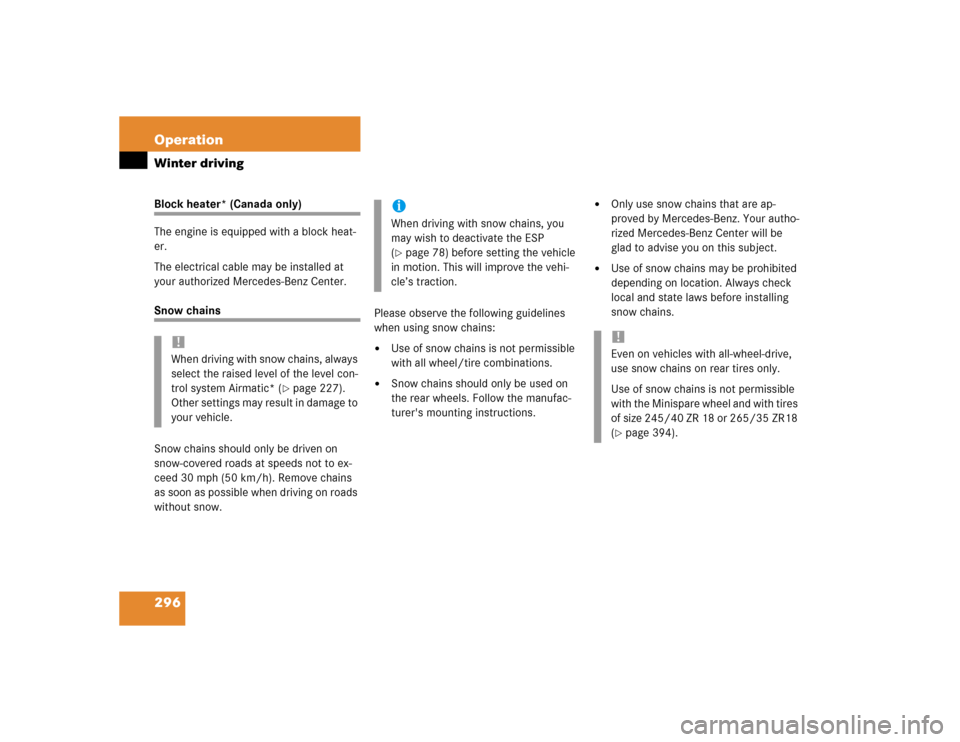
296 OperationWinter drivingBlock heater* (Canada only)
The engine is equipped with a block heat-
er.
The electrical cable may be installed at
your authorized Mercedes-Benz Center.Snow chains
Snow chains should only be driven on
snow-covered roads at speeds not to ex-
ceed 30 mph (50 km/h). Remove chains
as soon as possible when driving on roads
without snow.Please observe the following guidelines
when using snow chains:
�
Use of snow chains is not permissible
with all wheel/tire combinations.
�
Snow chains should only be used on
the rear wheels. Follow the manufac-
turer's mounting instructions.
�
Only use snow chains that are ap-
proved by Mercedes-Benz. Your autho-
rized Mercedes-Benz Center will be
glad to advise you on this subject.
�
Use of snow chains may be prohibited
depending on location. Always check
local and state laws before installing
snow chains.
!When driving with snow chains, always
select the raised level of the level con-
trol system Airmatic* (
�page 227).
Other settings may result in damage to
your vehicle.
iWhen driving with snow chains, you
may wish to deactivate the ESP
(�page 78) before setting the vehicle
in motion. This will improve the vehi-
cle’s traction.
!Even on vehicles with all-wheel-drive,
use snow chains on rear tires only.
Use of snow chains is not permissible
with the Minispare wheel and with tires
of size 245/40 ZR 18 or 265/35 ZR18
(�page 394).
Page 297 of 442
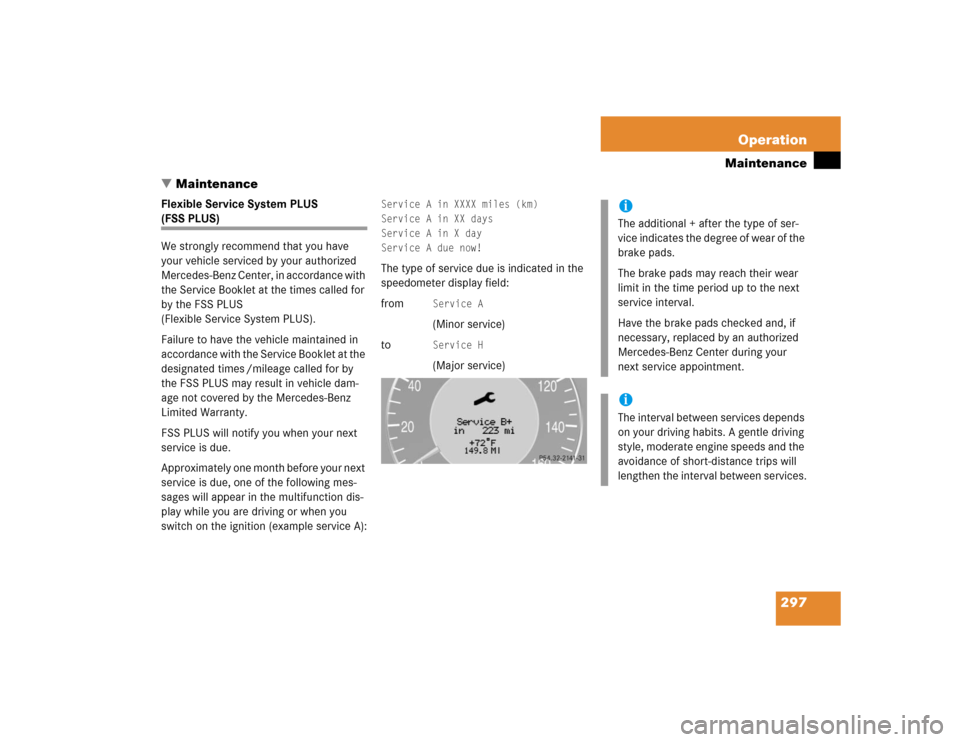
297 Operation
Maintenance
�Maintenance
Flexible Service System PLUS (FSS PLUS)
We strongly recommend that you have
your vehicle serviced by your authorized
Mercedes-Benz Center, in accordance with
the Service Booklet at the times called for
by the FSS PLUS
(Flexible Service System PLUS).
Failure to have the vehicle maintained in
accordance with the Service Booklet at the
designated times /mileage called for by
the FSS PLUS may result in vehicle dam-
age not covered by the Mercedes-Benz
Limited Warranty.
FSS PLUS will notify you when your next
service is due.
Approximately one month before your next
service is due, one of the following mes-
sages will appear in the multifunction dis-
play while you are driving or when you
switch on the ignition (example service A):
Service A in XXXX miles (km)
Service A in XX days
Service A in X day
Service A due now!The type of service due is indicated in the
speedometer display field:
from
Service A(Minor service)
toService H(Major service)
iThe additional + after the type of ser-
v i c e i n d i c a t e s t he d e g r e e o f w e a r o f t h e
brake pads.
The brake pads may reach their wear
limit in the time period up to the next
service interval.
Have the brake pads checked and, if
necessary, replaced by an authorized
Mercedes-Benz Center during your
next service appointment.iThe interval between services depends
on your driving habits. A gentle driving
style, moderate engine speeds and the
avoidance of short-distance trips will
lengthen the interval between services.
Page 312 of 442
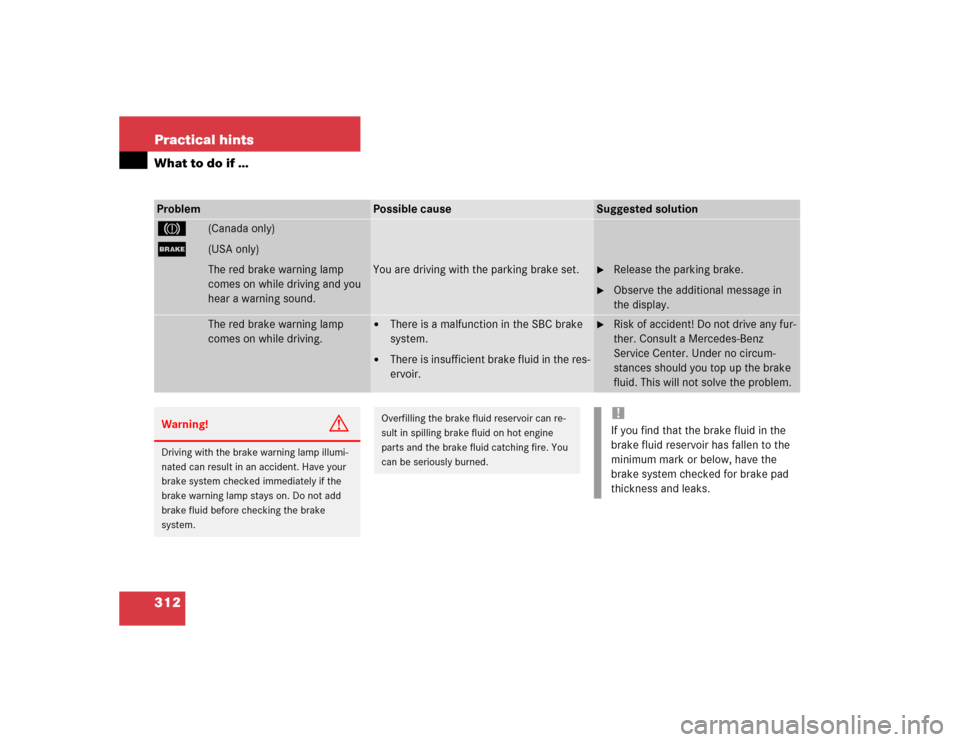
312 Practical hintsWhat to do if …Problem
Possible cause
Suggested solution
3
(Canada only)
;
(USA only)
The red brake warning lamp
comes on while driving and you
hear a warning sound.
You are driving with the parking brake set.
�
Release the parking brake.
�
Observe the additional message in
the display.
The red brake warning lamp
comes on while driving.
�
There is a malfunction in the SBC brake
system.
�
There is insufficient brake fluid in the res-
ervoir.
�
Risk of accident! Do not drive any fur-
ther. Consult a Mercedes-Benz
Service Center. Under no circum-
stances should you top up the brake
fluid. This will not solve the problem.
Warning!
G
Driving with the brake warning lamp illumi-
nated can result in an accident. Have your
brake system checked immediately if the
brake warning lamp stays on. Do not add
brake fluid before checking the brake
system.
Overfilling the brake fluid reservoir can re-
sult in spilling brake fluid on hot engine
parts and the brake fluid catching fire. You
can be seriously burned.
!If you find that the brake fluid in the
brake fluid reservoir has fallen to the
minimum mark or below, have the
brake system checked for brake pad
thickness and leaks.
Page 313 of 442
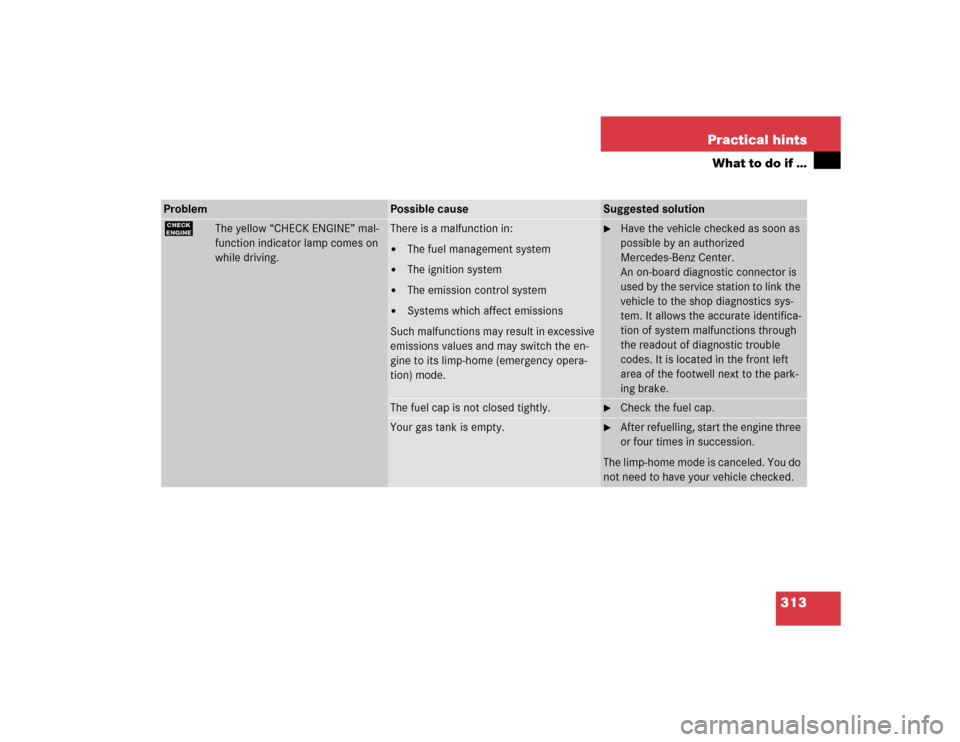
313 Practical hints
What to do if …
Problem
Possible cause
Suggested solution
?
The yellow “CHECK ENGINE” mal-
function indicator lamp comes on
while driving.
There is a malfunction in:�
The fuel management system
�
The ignition system
�
The emission control system
�
Systems which affect emissions
Such malfunctions may result in excessive
emissions values and may switch the en-
gine to its limp-home (emergency opera-
tion) mode.
�
Have the vehicle checked as soon as
possible by an authorized
Mercedes-Benz Center.
An on-board diagnostic connector is
used by the service station to link the
vehicle to the shop diagnostics sys-
tem. It allows the accurate identifica-
tion of system malfunctions through
the readout of diagnostic trouble
codes. It is located in the front left
area of the footwell next to the park-
ing brake.
The fuel cap is not closed tightly.
�
Check the fuel cap.
Your gas tank is empty.
�
After refuelling, start the engine three
or four times in succession.
The limp-home mode is canceled. You do
not need to have your vehicle checked.
Page 314 of 442
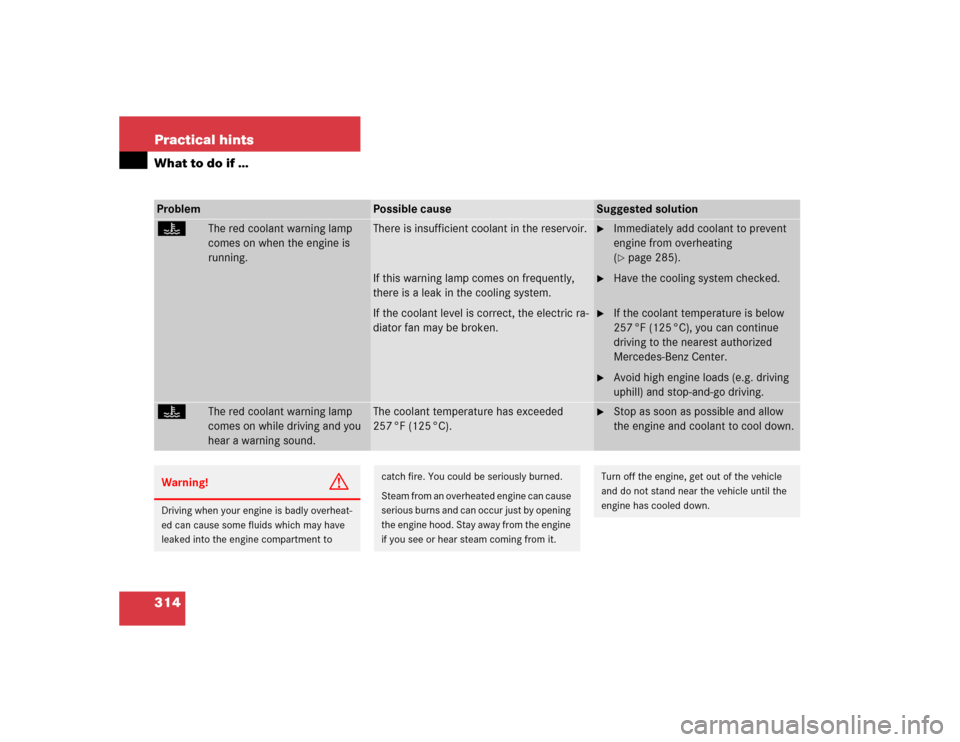
314 Practical hintsWhat to do if …Problem
Possible cause
Suggested solution
D
The red coolant warning lamp
comes on when the engine is
running.
There is insufficient coolant in the reservoir.
If this warning lamp comes on frequently,
there is a leak in the cooling system.
If the coolant level is correct, the electric ra-
diator fan may be broken.
�
Immediately add coolant to prevent
engine from overheating
(�page 285).
�
Have the cooling system checked.
�
If the coolant temperature is below
257 °F (125 °C), you can continue
driving to the nearest authorized
Mercedes-Benz Center.
�
Avoid high engine loads (e.g. driving
uphill) and stop-and-go driving.
D
The red coolant warning lamp
comes on while driving and you
hear a warning sound.
The coolant temperature has exceeded
257 °F (125 °C).
�
Stop as soon as possible and allow
the engine and coolant to cool down.
Warning!
G
Driving when your engine is badly overheat-
ed can cause some fluids which may have
leaked into the engine compartment to
catch fire. You could be seriously burned.
Steam from an overheated engine can cause
serious burns and can occur just by opening
the engine hood. Stay away from the engine
if you see or hear steam coming from it.
Turn off the engine, get out of the vehicle
and do not stand near the vehicle until the
engine has cooled down.